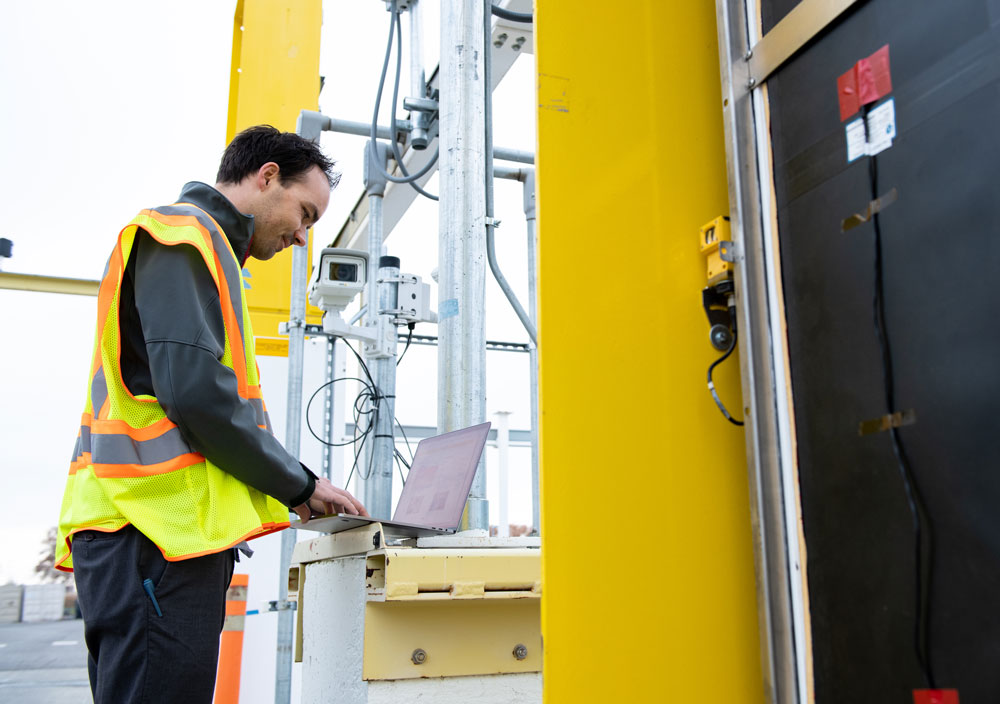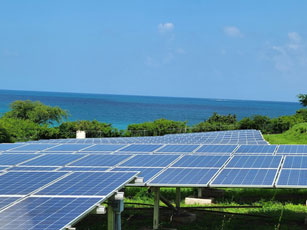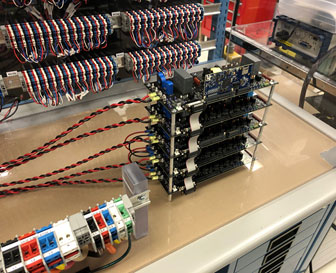
A song of ice and fiber
Sandia researchers have collected a first-of-its-kind seismic data set under the Arctic Ocean at Oliktok Point, Alaska, to record signals from sea ice formation and breakup, ocean wave height, sea ice thickness, whale vocalizations and seismic activity. The team partnered with telecom company Quintillion to attach a sensor system to a 38-kilometer-long “dark” optical fiber off the Beaufort Sea coast. This data set will allow researchers to better understand variations in the sensitive Arctic climate due to man-made and natural causes. (8000, LDRD)
Cybersecurity capabilities transitioned to CISA
Sandia transitioned Deception Orchestration Leveraging Open Source Intel capabilities to the Department of Homeland Security’s Cybersecurity and Infrastructure Security Agency’s Threat Hunting Emulation effort for use in their exercises. In addition, the tool’s automated dynamic-user-behavior-generation component will help analysts understand how to hunt and identify threats within realistic host logs derived from user interactions and resulting network traffic. The transition to a DHS agency illustrates the successful transfer of research and development work for the real world. (8000, 9000)
Power electronics for electric drivetrains
Sandia has developed a process for fabricating vertical gallium nitride-based trench metal-oxide-semiconductor field-effect transistors for use in electric drivetrains. Their vertical topology promotes more efficient scaling toward high-power applications, where both high voltage and high current are necessary. Vertical gallium nitride devices are gaining traction for high power applications as they promise increased performance and power density compared to conventional silicon or even silicon carbide-based systems. For electric vehicle drivetrains, the advantages of vertical gallium nitride devices translate to more miles driven per charge and more compact charging solutions. (8000)

Redesigning ports-of-entry radiation monitors
Sandia has designed an interface specification for modular radiation portal monitors for ports of entry into the U.S. and supported the Department of Homeland Security in an Industry Day event and request for information to industry. The modular design is expected to allow improved detection sensitivities and reduce false-positive alarms while providing flexibility for operations and easier upgrades. Sandia has also developed a best-in-class alarm algorithm for portal monitors and is actively developing further machine learning capabilities to support the mission. (6000, 8000)

Combating Ebola using CRISPR technology
To rapidly develop antiviral therapeutics, Sandia used CRISPR gene-editing technology throughout the Ebola countermeasure development pipeline, from target discovery and validation to using the CRISPR tools as next-generation therapeutics. Recently, the team reported 100% survival against Ebola infection in mice when pretreated with lipid nanoparticles containing CRISPR reagents targeting a critical host factor gene. This method severely hindered the virus’s ability to replicate. Ebola studies were performed in collaboration with the University of Texas Medical Branch in biosafety level-four containment. (8000)
Successful counter-unmanned aerial systems tests
A Sandia team conducted about 40 tests against unmanned aerial systems during a three-day test event in Washington, D.C., in support of the Department of Homeland Security Science and Technology Directorate, Federal Protective Service and U.S. Coast Guard. The team verified key operational aspects against DHS requirements despite facing significant weather, airspace and equipment challenges. This effort, and future testing, enables DHS to assess how well candidate technologies can sense, track, identify, and mitigate unmanned aircraft system threats at key facilities, and advise DHS on the realities of performance. (6000)
Hydrogen breakthrough through machine learning
A team of materials and computer scientists used machine learning to identify new alloys with the potential to release hydrogen at much lower temperatures compared to existing technology. They then created a dozen new alloys from a set of 600, earning the cover of the Chemistry of Materials for a paper detailing their methods. Additionally, these high-entropy alloy hydrides could enable a natural cascade compression of hydrogen as it moves through the different materials, potentially revolutionizing domestic hydrogen infrastructure. (8000)

Puerto Rico energy resilience
Following Hurricane Maria in Puerto Rico, Sandia provided tools to ensure that billions of dollars of recovery funds were spent to enable energy resilience and provide critical services to the country. Sandia partnered with two Puerto Rican universities, where professors and students further developed and implemented Sandia tools to address local issues and maximize local impact. Communities were directly engaged, such as through the recent microgrid design workshops Sandia led in Culebra and Vieques, where community leaders were active participants. (8000)
Gen3 particle pilot plant
Sandia developed and advanced the use of particles as a heat-transfer media to achieve temperatures higher than 700 degrees Celsius and receiver designs of greater than 80% efficiency. Further investigations confirmed the safety of the receiver by measuring low-particle emissions and the promise of advanced particle conveyance systems and thermal storage design for particles. As a result, Sandia was awarded a $25-million project to construct and test the first 1 megawatt of thermal heat, particle-based concentrating solar power tower with a 5-MW receiver, and 6 MW per hour of thermal storage. These enhancements reduce the risk of technology failure and lower the cost for commercial system use. (8000)

Scalable power conversion for energy storage
The multiconverter system developed in the Advanced Power Electronic Conversion Systems lab provides the power conversion and control functions necessary to integrate multiple energy storage systems into a single grid asset. The purpose of this multiconverter is to validate new circuit topologies and control methods that improve the performance, reliability and survivability of utility-scale storage installations. The system demonstrates the lab’s end-to-end design, implementation and integration capabilities, which provide a streamlined pathway for the development and maturation of innovative power conversion solutions. (8000)